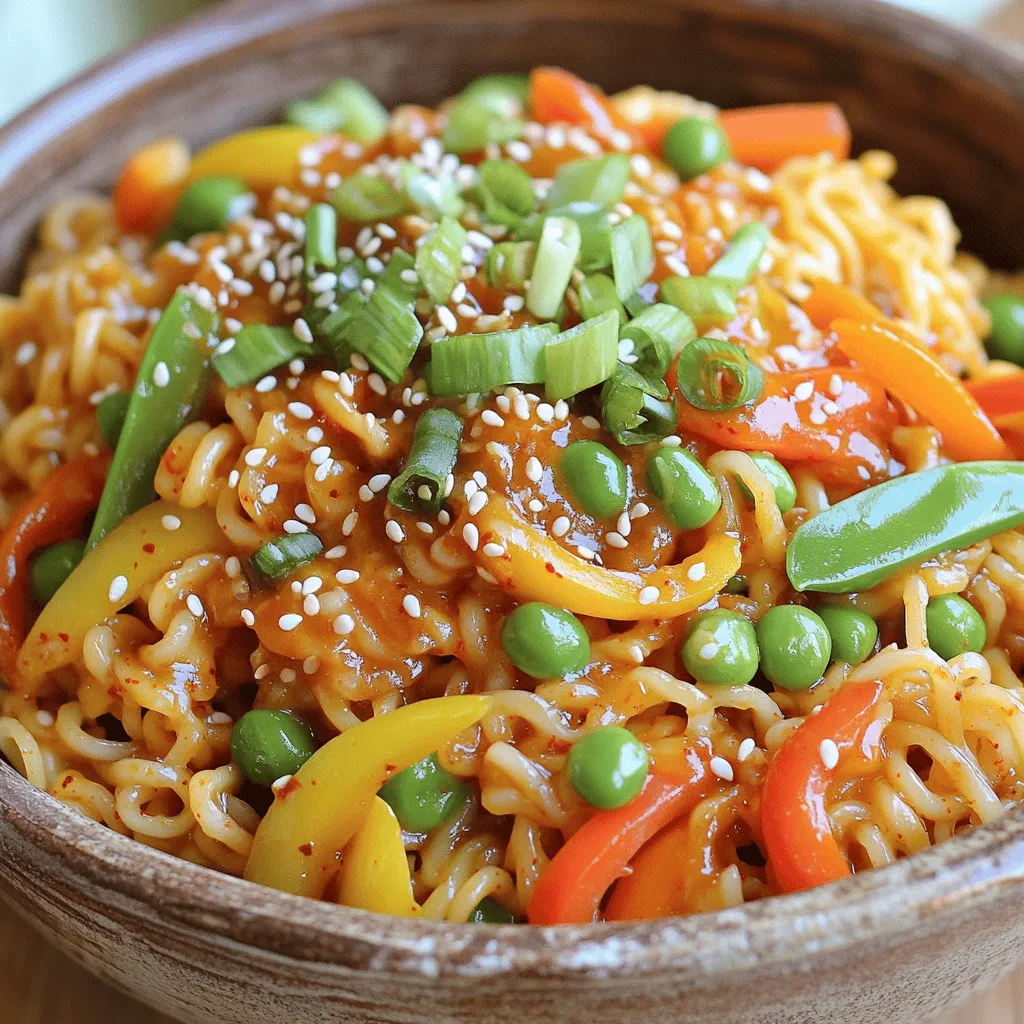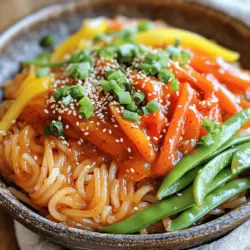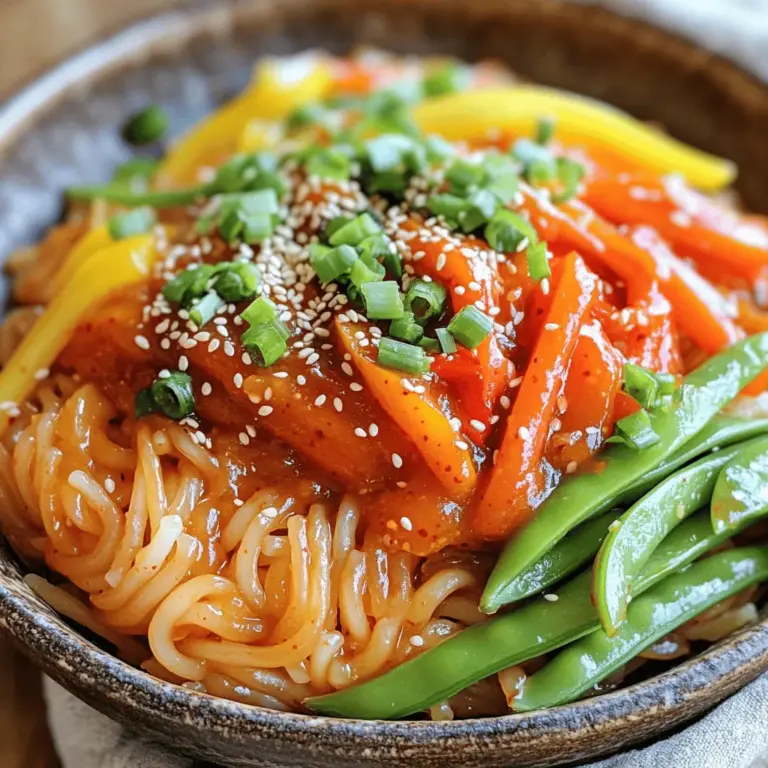Are you ready to spice up your dinner routine? In this post, I’ll share a simple and tasty recipe for Korean Gochujang Noodles. With just a few ingredients, you can create a flavorful dish that’s both healthy and satisfying. I’ll also provide tips, variations, and storage advice to help you enjoy these noodles again and again. Let’s dive into this delicious meal together!
Ingredients
List of Ingredients for Korean Gochujang Noodles
– 8 oz (225g) rice noodles
– 2 tablespoons vegetable oil
– 1 cup bell peppers (red and yellow), sliced
– 1 cup carrots, julienned
– 1 cup snap peas, trimmed
– 3 green onions, chopped (reserve some for garnish)
– 2 cloves garlic, minced
– 3 tablespoons gochujang (Korean chili paste)
– 2 tablespoons soy sauce
– 1 tablespoon sesame oil
– 1 teaspoon honey
– 1 teaspoon rice vinegar
– Sesame seeds for garnish
Health Benefits of Each Ingredient
Rice noodles provide a gluten-free option rich in carbs for energy. They cook fast and soak up flavors well.
Vegetable oil is a great source of healthy fats. It helps cook the veggies without burning.
Bell peppers are full of vitamins A and C. They boost your immune system and add color.
Carrots are excellent for your eyes. They have beta-carotene, which your body turns into vitamin A.
Snap peas add fiber and protein. They help you feel full and support digestion.
Green onions have antioxidants and can improve heart health. They add a mild onion flavor.
Garlic has many health benefits. It can help lower blood pressure and boost immunity.
Gochujang is spicy and sweet. It contains probiotics, which help gut health.
Soy sauce adds umami flavor. It contains amino acids that can aid in muscle repair.
Sesame oil is rich in antioxidants. It adds a nutty flavor to the dish.
Honey is a natural sweetener. It has antioxidants and can soothe coughs.
Rice vinegar helps balance flavors. It may help with digestion and weight loss.
Sesame seeds are tiny powerhouses. They contain healthy fats, protein, and minerals.
Where to Buy Gochujang and Other Ingredients
You can find gochujang at most Asian grocery stores. Check the international aisle in big supermarkets too.
Rice noodles are often found near the pasta or in the Asian section. Look for brands that make rice noodles.
Fresh veggies like bell peppers, carrots, and snap peas are best at local markets or grocery stores.
Green onions can be found in the produce section, usually near the herbs.
Garlic is widely available. Buy fresh cloves or pre-minced for ease.
For soy sauce and sesame oil, look in the Asian foods aisle or specialty shops.
Honey and rice vinegar are common in most grocery stores. Check the baking or condiment sections.
Lastly, sesame seeds are easy to find. Look for them in the baking aisle or near spices.
Step-by-Step Instructions
Cooking the Rice Noodles
Start by boiling water in a large pot. Once boiling, add 8 oz of rice noodles. Cook the noodles according to the package instructions. You want them to be al dente, which means they should still have a bite. After cooking, drain the noodles and rinse them under cold water. This stops the cooking process. Set the noodles aside for later.
Stir-Frying the Vegetables
In a large skillet or wok, heat 2 tablespoons of vegetable oil over medium-high heat. Add 1 cup of sliced bell peppers, 1 cup of julienned carrots, and 1 cup of trimmed snap peas. Stir-fry the vegetables for about 4 to 5 minutes. You want them to begin softening but still be crisp. This adds great texture to your dish. Next, add 2 cloves of minced garlic and 3 chopped green onions. Stir-fry for an extra minute until you can smell the garlic.
Preparing the Gochujang Sauce
In a small bowl, mix together 3 tablespoons of gochujang, 2 tablespoons of soy sauce, 1 tablespoon of sesame oil, 1 teaspoon of honey, and 1 teaspoon of rice vinegar. Whisk until smooth. This sauce adds a sweet and spicy kick to your noodles.
Combining and Serving
Now it’s time to bring it all together. Add the cooked noodles to the skillet with the vegetables. Pour the gochujang sauce over the noodles. Toss everything together until the noodles are well coated. Heat everything for about 2 to 3 minutes. This step makes sure that the flavors blend well. Transfer the gochujang noodles to serving bowls. Garnish with reserved green onions and a sprinkle of sesame seeds. Enjoy your delicious dish!
Tips & Tricks
How to Achieve the Perfect Noodle Texture
To get the best noodle texture, follow these steps:
– Choose rice noodles: They have a great chew and soak up flavors well.
– Cook to al dente: Boil them just until they are firm but not hard.
– Rinse with cold water: This stops the cooking and prevents stickiness.
This technique keeps the noodles from clumping together later.
Cooking Techniques for Enhanced Flavor
For richer flavor in your gochujang noodles, try these tips:
– Use high heat: Stir-frying over high heat helps lock in flavors.
– Add aromatics early: Sauté garlic and green onions first to release their oils.
– Toss quickly: Stir-fry quickly to keep the veggies crisp and vibrant.
These methods will give your dish depth and a tasty kick.
Suggested Garnishes and Serving Suggestions
Garnishing makes your dish look great and adds flavor:
– Chopped green onions: Sprinkle these on top for a fresh, oniony taste.
– Sesame seeds: Add these for a nutty crunch.
– Chili flakes: If you want more heat, sprinkle some chili flakes on top.
Serve your gochujang noodles in a bowl and enjoy with chopsticks for an authentic experience.

Variations
Vegetarian and Vegan Options
You can easily make this dish vegetarian or vegan. Simply skip the honey or use a plant-based sweetener. For extra flavor, add tofu or tempeh. You can sauté them until golden and crispy, then toss them in.
Protein Add-Ins for a Hearty Meal
If you want more protein, chicken, beef, or shrimp work great. Just cook the protein first. Remove it from the skillet and set it aside. Then stir-fry the veggies as usual. Add the protein back in when you mix everything together.
Gluten-Free Alternatives
If you need gluten-free noodles, use rice noodles, which are perfect here. You can also find gluten-free soy sauce. Just check the label to be sure.
Storage Info
How to Store Leftovers
After you enjoy your Korean gochujang noodles, store any leftovers in an airtight container. This keeps out air and moisture. Place the container in the fridge. The noodles will stay good for up to three days.
Reheating Instructions
When you are ready to eat your leftovers, you can reheat them easily. Use a microwave-safe bowl. Add a splash of water to keep them moist. Heat in the microwave for about two minutes. Stir halfway through to warm evenly. You can also reheat them in a skillet. Just add a little oil over medium heat. Stir for about five minutes until hot.
Freezing Gochujang Noodles
You can freeze gochujang noodles for later. First, let the noodles cool completely. Then, place them in a freezer-safe bag. Squeeze out as much air as you can before sealing. Label the bag with the date. They will stay fresh for up to three months. To enjoy, thaw them in the fridge overnight. Reheat as mentioned before.
FAQs
What is Gochujang and How is it Used?
Gochujang is a Korean chili paste. It has a thick texture and a deep red color. This paste combines heat and sweetness. It often contains fermented soybeans, salt, and sugar. You can use gochujang in many dishes. It adds flavor to soups, stews, and marinades. I also love it in Korean Gochujang Noodles. The heat from gochujang makes the dish exciting and tasty.
Can I Substitute Other Sauces for Gochujang?
Yes, you can use other sauces if needed. Sriracha can work for some heat. However, it lacks the unique sweetness. You might mix sriracha with miso paste for a better match. Another option is chili garlic sauce, but it will change the flavor. If you want a sweet taste, add sugar or honey. Remember, these substitutes change the dish’s final taste.
What Are Some Popular Brands of Gochujang?
Some brands stand out in the market. I recommend Chung Jung One and Sunchang. These brands have good flavor and quality. You can find them in Asian grocery stores or online. They offer different heat levels too, so choose what you like. Always check the label for the best choice.
How to Adjust the Spice Level in Gochujang Noodles?
To lower the spice, use less gochujang. Start with one tablespoon. Taste the dish, then add more if you want it spicier. You can also mix in a bit of sugar or honey. This addition balances the heat. For extra spice, add more gochujang or a dash of chili flakes. Adjust to your taste for a perfect meal.
Korean Gochujang noodles are simple, tasty, and good for you. We explored the key ingredients, their health benefits, and where to find them. You learned how to cook the noodles, stir-fry the veggies, and make the flavorful sauce. Don’t forget the tips for perfect texture and great garnishes. You can also try veggie options, add protein, or go gluten-free. Store leftovers well and follow the reheating tips. Enjoy making this dish your own!


